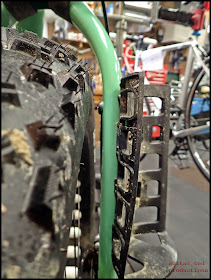 |
| A glaring fault with 2015 Mukluks and Blackborows |
In all cases, the cable/hose routing runs to the inside of the fork leg at a point that is within millimeters of the widest part of the tire casing. Not only that, but as the cable/hose enters the cable guide from above, it tends to come within a whisker of contacting the tire.
Only through a judicious shortening of the stock cable, or by adding an unsightly cable tie, can you avoid having the front brake housing/hose hit the tire. This would not be a "deal breaker" if the cable guide had been mounted a bit further up the fork leg, so as to avoid the widest part of the tire casing, but as you can plainly see by my images, that is not the case on the Blackborow, nor is it much different on current Mukluks. This placement causes mud, snow, ice, and dirt to accumulate right where you don't want it to, clogging the fork and in extreme cases, it can stop the front wheel from rotating freely. I know- there was this one foray into a muddy, clay filled construction site, and....... You get the picture.
 |
| Another look without the wheel in place. |
I decided to defer to the design choice for a while to see if it was just me, or if it was actually going to be a problem that I would have to be concerned with. On all fronts mentioned, I turned out to be correct in my initial analysis. That meant that I needed to make a modification, and I had a pretty good idea of what it was that would rectify the problems. This post outlines a really simple, easy solution that anyone should be able to employ to make their 2015 Mukluk or Blackborow with a rigid Salsa fork a better bike.
NOTE: Before I continue I should say that this is a modification of the brake cable housing/hose guide only. It may or may not void a warranty, and is not advocated by Salsa Cycles, so consult with your Salsa Cycles dealer ahead of doing anything before making this mod. Also- Unless you are comfortable doing some handiwork with a hammer and vice, and if you are not very skilled as a craftsman, you should defer to a more talented person or take this idea to the local bike shop.
Okee-doekee? Let's move on then..........
 | |
| You'll need a plastic covered "P-clamp", a ball peen hammer, and something round, steel, and that is approximately 5mm in diameter. |
 |
| Your formed "P-clamp" should look something like this when you are done. |
This might be the most difficult part for many of you, so if you are not comfortable wielding a hammer on a vice to form metal, you may want to seek out assistance with this step. It is critical that the opening you, (or whomever does the work), forms is round and not ovalized. Otherwise it doesn't matter how it looks unless you are OCD about how things look. Then, well.......that's another story. You will notice that in my example the ends overlap. I needed to trim off the "shorter" tab.
 |
| Trimmed, deburred and ready to install. |
Anyway, I bent the overlapping, shorter tab upward and trimmed it back with some heavy duty end cutters. I then deburred that with a file, and also rounded off any other sharp edges. After I was satisfied that I had everything as good as I could make it, I went ahead and installed the new brake cable housing/hose guide in place using the same button head bolt that came with the original guide.
 |
| Hmm.....well, I shouldn't have drilled and tapped that extra hole- since it was unnecessary, but there it is..... |
 |
| Perfectly out of the way now! |
You'll also note that the entrance from above to the guide is placed well away from the tire, not as it is with Salsa's solution, and there is no way that the cable will ever come in contact with the tire in this arrangement. One unforeseen advantage to setting up the brake cable/hose guide this way was that now I do not have to thread the Anything Cage straps around the brake cable housing, but I can route those straps underneath and directly onto the fork blade. This may help to avoid further damage to cable housings down the road.
Take away my extra hole gaff, and this solution is far superior to the stock arrangement in every way. It enhances tire to fork clearances, and it is safer, in my opinion, since there is no way the guide can damage the cable housing, nor is there any further cause for concern with the tire snagging the cable housing at some point. Plus, the cost to make this improvement is a simple "P-clamp" and a bit of time.Plus, if you use a new "P-clamp" and don't drill the extra hole, yours will look better than mine does. So, ya know- there is that to shoot for as well!
I've got to say that this detail is curious as it comes stock from Salsa. Looking at the Makwa carbon fork, or the previous steel Enabler fork shows elegant solutions that are functional and clean as far as cable routing goes. At least it is an easy to fix flaw in an otherwise great bike. If you have any questions about what I did here, feel free to e-mail me at g.ted.productions@gmail.com or leave a comment in the comments section. I'll answer your questions the best I know how.

Thanks for posting the instructions for this mod! On a recent muddy ride, i watched as mud and gunk started to gather at the brake cable on my DS and decided to do something about it. Looks great and works great!
ReplyDelete